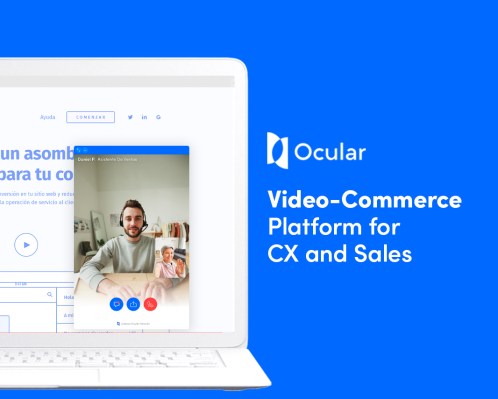“The pandemic made it visible that there was a missing piece in the customer journey: video chat,” says Fernando Moya, CEO of early-stage Chilean startup Ocular Solution.
According to Moya, COVID-19 made it obvious that live chat and chatbots were not enough, as people were still hoping to interact face-to-face with customer agents — just like they do offline.
This is what Ocular Solution, which participated in Startup Alley at TechCrunch Disrupt, is hoping to solve in the digital world, with a platform that helps clients add a video chat element to their site and integrate it with their existing tools, from HubSpot to Pipedrive.
Video chat can come in handy for customer support, but also for onboarding and sales. The latter is especially true if the service is a good fit for consultative selling, in which the end user is hoping to get questions answered before proceeding.
This desire to talk to a real person explains why Moya sees video chat as an efficient way to reduce cart abandonment rate — a major issue for e-commerce. Aggregating data from 44 studies, UX research institute Baymard estimated the average documented online shopping cart abandonment rate at near 70%.
There are many reasons for site visitors not to turn into customers, but Ocular found out that offering video chat can help boost conversions. The startup’s customers boast an average service-related net promoter score of 8, Moya told TechCrunch, with conversion rates starting at 15% and peaking at 250% during Chile’s e-commerce promotion event CyberDay.
Ocular launched in Chile, where Moya had previously co-founded another company, Wingsoft, which Ocular spun out of. But the startup is already looking beyond borders: It plans to keep its team remote, albeit with small hybrid hubs; and it already has clients in other Latin American countries.
Latin America’s e-commerce hasn’t reached the same penetration levels than in North America and Western Europe, but sales are increasing at a faster pace than in other regions. These new online consumers are arguably more likely to look for an experience that is more similar to in-person shopping. “The quantity of people requiring video assistance is growing very fast,” Moya said.
Customer satisfaction and sales aside, Ocular is also hoping to help its clients improve their internal processes. As a result, it provides companies with data to help them track key metrics related to customer service, while helping attendants do their job. “We train your agents so that they deliver the best service experience and can get the most out of the tools,” its site explains.
“We believe that agents play a key role in the use of our technology; they humanize this new customer service channel,” Moya said. “Therefore, our efforts are focused on generating tools that allow them to improve day by day, that motivate them and generate profits as the result of them performing well, within an entertaining and challenging environment.”
Moya expects more people to want to become video chat attendants and predicts an upcoming “uberization” of this segment. This could help answer growing demand for these services: “Use cases for video support are varied, and new ways of applying it are appearing every day.”

